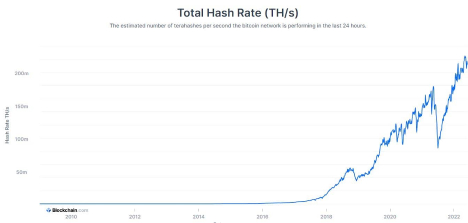In cryptocurrency and blockchain technology, the hash rate refers to the number of computations that were processed per second by all nodes while the attempted to crack the hash value of the hashing algorithm.
The hash rate or ‘hashrate’ is the total number of nodes (computational power) being used by a cryptocurrency blockchain network to produce proof-of-work (POW) algorithms while processing transactions. The POW is one method of adding new blocks to a blockchain by having the nodes in the blockchain network verify all transactions on the blockchain through the hashing process.
The hash rate is calculated on a per-second basis by taking into accounting the total number of calculations that are process each second by all of the computing nodes in a particular blockchain network. This constantly varies according to the number of nodes that are currently involved in the mining process at any given moment.
For instance, according to Blcockchain.com, on January 1st 2012 the Bitcoin (BTC) blockchain was hashing at a hash rate of 8.9 million terahashes per second. Then:
- On November 14th 2019: 94 million terrahashes p/s
- On July 3rd, 2021: 85 million terahashes p/s
- On May 11, 2022: 222 million terahashes p/s

The amount of computing power required for POW depends on the hashing algorithm. The algorithms that are usually utilizes are the MD5, SHA-1, RIPEMD-160, Whirlpool, SHA-2, SHA-3, BLAKE2 and BLAKE3 hash algorithms. The Bitcoin (BTC) blockchain utilizes the SHA-256 hash algorithm.